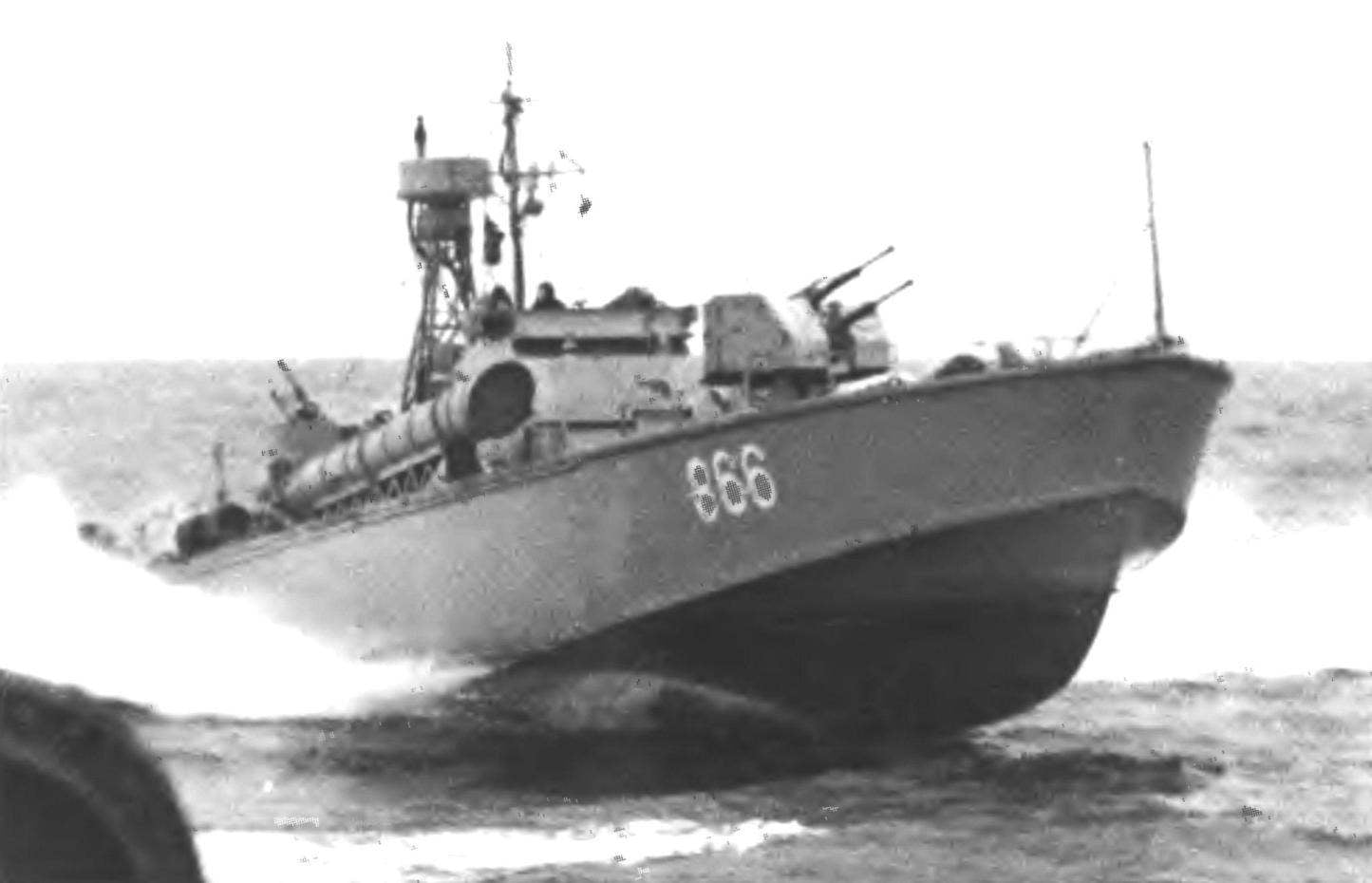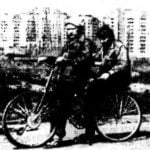 (The end. Beginning at No. 9 in’05). In may 1953, in connection with the liquidation of the 4th special Department (former MGB, and now the Ministry of internal Affairs of the USSR), OKB-5 was closed, and its civilian employees became part of the SKB-5 for the design of long-range boats was established on 22 October 1949 at plant No. 5 Minsudprom of the USSR. Here they continued further development of the boat of the project 183, including in the directions laid down in the OKB-5 MGB.
(The end. Beginning at No. 9 in’05). In may 1953, in connection with the liquidation of the 4th special Department (former MGB, and now the Ministry of internal Affairs of the USSR), OKB-5 was closed, and its civilian employees became part of the SKB-5 for the design of long-range boats was established on 22 October 1949 at plant No. 5 Minsudprom of the USSR. Here they continued further development of the boat of the project 183, including in the directions laid down in the OKB-5 MGB.
A large torpedo boat of the project 183 in all of its tactical and technical characteristics and technological qualities were evaluated by national experts as very promising. However, in the beginning of serial production was an obvious need for further improvement: increase speed and gain weapons in order to match the requirements of the time. The first was dictated by the slight difference in speed with the main enemy in repelling torpedo attacks with destroyers; the second, a small number of torpedoes in a salvo. And artillery weapons fighting was inferior to the boats potential opponents, who had not only the 20-mm and 40-mm artillery systems.
Modernization potential developers of the boat, is allowed to increase its tactical and technical characteristics. One of the most interesting modifications of the boat of the project 183, made in OKB-5 with the purpose of increasing the maximum speed was the option of a combined power plant. As an accelerator to increase the maximum speed on the boat in addition to four diesels M-50Ф mounted gas turbine engine. By this time, had information on the work of foreign shipbuilders in this direction.
In 1946 — 1947, the British boat coastal defense MGB2009 one of three petrol engines with a capacity of 1250 HP replaced a gas turbine engine (GTE) with a capacity of 2500 HP, which allowed to increase the maximum speed of a boat with a displacement of 100 tons at 5 knots. Given the positive results of operation of the boats the British Admiralty took the decision on the construction of two patrol boats with a displacement of 150 tons with a combined power plant consisting of two diesel engines with a capacity of 2500 HP and two gas turbines with a capacity of 4000 HP Each engine running on your propeller. Maximum speed of the boats was 43 knots.
In 1948 the Ministry of aviation industry of the USSR held a competition for the development of a turboprop engine (HPT) with a capacity of 4000 HP for future aircraft. The competition was attended by design Bureau N.D.Kuznetsov and S. D. Kolosov. The engine, developed under the leadership of Kuznetsov, was brought before, and accepted for production, and theater Kolosova remained unclaimed. Then S. D. Kolosov suggested to use it as the accelerator on the prototype of the torpedo boat P. G. Hoinkes, failing to contact the chief designer and find out the parameters required customs Declaration, the terms of readiness and delivery.
Initiative S. D. Kolosov received the support of the Minister of the shipbuilding industry and the Vice-Chairman of the Council of Ministers of the USSR VA Malyshev. Due to his active support in August
1950 issued a decree of the USSR Council of Ministers about the carrying out of works on creation of the first Russian ship GTD by modification of turboprop aircraft structures]. The modified engine was given the index TRDV. In December 1950, P. G. Hoinkes approved the technical design of the boat combined installation, get the number 183Т. In April 1951 at plant No. 5 laid the prototype of a new boat with factory № 519. In the summer
1951 the year the engine passed official TRD 100-hour bench test on the engine factory No. 16 in Kazan and was accepted the interdepartmental Commission of the Navy, Minaviaprom and Minsudprom. Three prototypes of the engine with the factory №№ 5, 6 and 7 were sent for installation on the boat. 2 Sep 1951, it launched the accelerator TRDV No. 5.
2 Nov 1951 at check of reliability of TRD on fifty percent power for a speed of 40 knots and a strong vibration of the housing. The test was stopped and the engines returned to base. During the inspection TRDV found the destruction of the bearing of the turbine resulting in destruction of the coupling between the engine and gearbox and front engine mounts. The causes of the accident, according to experts, was a hard motor mount and the poor performance of the lubrication system To continue testing boat engine mounts supplied with shock absorbers and modified lubrication system. Adopted measures proved insufficient, and in August 1952 during testing, not after ten o’clock, broke down engine No. 7, with destruction similar to the previous case.
For finishing gas turbine drive support TRDV No. 6 fulfilled the hinge, replaced the coupling is more flexible, once again improved the lubrication system. Then modified the accelerator, the power plant successfully passed the bench tests, and on the boat was installed already advanced TRD NO. 7M, which in August 1953 and was completed the state testing program.
The state Commission noted that the engine design S. D. Kolosov is the first gas turbine engine in the Soviet Union, applied to the ships of the Navy. Among the criticisms, the Commission noted the insufficient strength of the hull of the boat; a limited ability to travel at a speed of 50 knots — only at sea, not above two points; poor living conditions of the crew, TRD high noise levels and increased fuel consumption. In its current form, the Commission recognized pilot boat No. 519 satisfying the tactical and technical requirements for a large torpedo boat and did not recommend it as a sample for serial construction.
The creators of torpedo boats shared the views of members of the state Commission, especially that the main purpose of the boat project 183Т they saw the obtaining of experimental data in developing a combined power plant with a fundamentally new type of engine. Therefore, along with the testing of the prototype boat No. 519 at OKB-5 was the design of advanced torpedo boats. When they were taken into account the results of the tests, developed new equipment.



A large torpedo boat of the project 183:
3 — the instrument is smoke generation; 5 —daugavmala turret 25-mm gun mount 2M-3M; 6 — fire pump; 10 mainmast; 11 — antenna; 13 — antenna VHF-radio; 21 — vent; 27 and 28 with brackets of the prop shaft; 29 — thruster 1ДГ-yuo; 30 — steering wheel; 31 — Minna scat; 32 — a guard switching boxes; 33 — rack smoke buoy; 34 and 36 cover the technological hatches; 35 — on-Board release gear for depth-bombs; 37 — fender first shots of the installation 2M-3M; 38 — a similar vestibule; 39 — the base of the mainmast; 43 — guy; 50 — soles; 51, 53 and 54 of the anchor pillow; 52 — threaded stopper; 55 — cover entrance hatch; 56 — tilting plate; 58 — Danforth anchor; 60 — Proclus; 64 — lamp bottom aft of the fire; 74 Serena; 77 — antenna input; 84 — binnacle magnetic compass; 85 — torpedo sight; 88 — dashboard; 92 — top fire; 93 antenna of the radar identification; 94 — fire kotikovye; 95 — flag halyard; 96 — FAL pennant; 97 signal halyard; 98 — basket of fire hoses; 99 — fire barrel; 100 — powder extinguisher; 101 — fire hose; 102 bomb rack; 103 — depth charge BM-1; 104 — account the capacity of the coolant to install the 2M-3
So, on a torpedo boat of the project 183ТУ with a normal displacement of 81 tonne has been used for the combined power-plant of four diesel engines M-50ФТК, uprated to 1500 HP, and one TRD. Established four 533-mm torpedo tubes, and to control their shooting — device (PUTTS) “Rope” with automatic data retrieval from radar “Reya”. With the aim to optimally use the capacity of the power plant the transmission from the engines to the propellers was performed through a two-stage gearboxes. Alternatively, they were considered and controllable pitch propellers. The developers of the boat was calculated to obtain a maximum speed of 55 knots, and a cruise of about 30 knots.
Difficulties faced by project developers torpedo boats 183ТУ, was forced to return to the consideration of trade-offs of modernization boats 183 combined power plant.
For series-built boats were needed to organize the production of TRD. Minaviaprom categorically refused to produce them, citing an overload of plants to your program. V. A. Malyshev once again supported OKB S. D.Kolosova, and the creators TRD settled under construction at the time the South turbine plant (Yutz) in Nikolaev. In may 1954 issued a decree of the USSR Council of Ministers, which provides for Yutz basis for the design of ship gas turbine and serial production.
A revised draft pilot version of the boat 183Т got the code 183ТК. In the course of its elaboration to the level that meets the Navy, strengthened the case by increasing the thickness of the plating of the sides and bottom. Have perekomponovkoy nasal compartments with the purpose of finishing the habitat conditions of the crew to the source 183. Minimized the amounts employed in the housing of the air inlet tract TRD; instead of the bulky air intake on the deck of the engine air now flows through the air intake slits on the bow and side walls of the cabin. Radiokatu moved out of the housing in an enlarged superstructure; spread on the body, the nozzle TRDV and radar. Included the replacement of the radar “Zarnitsa” more modern “ray” and the installation of a new improved device the shooting of “Rope”. Boats equipped with accelerator GTE M-1 (the name given to the modification TRD made on the Nikolaev Yutz). On this project in 1955 and 1957, the plant № 5 built 25 boats, which is almost equally distributed between black sea and Baltic fleets.
One of the prototypes of the boats of the project 183, known as the 183A project, built with a shell of panels of plasticized wood, obtained by impregnation of wood veneers with glue VIAM-ZB. This material appeared in the 1930-ies under the name Delta-wood. It was used in aviation for the manufacture of power components as an alternative to aluminum alloys. It differs from ordinary wood large moisture resistance and specific strength. There was a variation of that material. Inventor O. F. Kaplun working in the Breeze nsra, built boats from “coprolite” — reinforced mesh Delta-wood. At the Moscow plant № 28 has developed production technology of this material is aircraft ski and screws; it was widely used during the great Patriotic war in the manufacture of A. S. Lavochkin fighters. However, the use of Delta-wood in the project 183A desired result is not delivered, so the boat has remained in one piece.
To support combat training of the fleet on the base of torpedo boats of the 183-year project built 60 RC boats target project 183Ц.
In 1952, SKB-5 directed the development of boats with missile weapons. This work was headed by chief designer E. I. Yukhnin. In 1954 was released technical project missile boats.
After the start of anti-ship cruise missiles P-15 on the ground stand in 1956 and 1957 at the shipyard № 5 for testing was equipped with launchers, two torpedo boats, the designation “project 183Э”. With one of them on 16 October 1957 in the Black sea produced the first launch of a cruise missile. In the future, in factories No. 5 (Leningrad) and No. 602 (Vladivostok) built 112 boats 183r type with missile weapons, while 54 of them were converted from previously issued torpedo boats.
On the basis of the torpedo boat project 183 SCB-5 in 1953 he designed the small hunter project 199. Torpedo dismantled. The number of depth charges on two release gear BMB-2 increased to 36. Small hunter was equipped with sonar “Tamir”. The maximum speed of this modification — 35 knots, cruising range 12-node swing — 1000 miles. Plant No. 5 to 1959 built 52 small hunter of this project.
The latter, built under the leadership of Paul Gustavovich of Hoinkis in 1956 — 1959, was a large torpedo boat of project 206 steel case, possessing elevated performance characteristics. It was armed with four 533-mm single-tube torpedo tubes and artillery radar system. On the basis of the 206-th and preceding the torpedo boat project 183, has developed several modifications of missile boats armed with four missiles P-15.
Created by P. G. Hoankiem post-war generation combat craft has been recognized not only in the domestic fleet, but also abroad. In 1960, the scientific Council of CRI named after academician A. N. Krylova “on set versatile work and achievements, aimed at the creation of the Russian fleet”, awarded P. G. Hoinkes the degree of doctor of technical Sciences without defending a thesis.
Basic tactical and technical characteristics of the large torpedo boat of the project 183
Displacement:
standard/full t: ………..61,5/66,5
Dimensions: length x width x draught, m………… 25,4×6,24×1,24
Armament:
torpedo, Qty x type……..2х533 mm TCA-53M
artillery, number x type ammunition…………2×2 25 mm 2M-3
4000 shots anti, number x type…………………………..8 x BB-1
Powerplant:
number x type…………..4 x diesel M-50Ф
power, HP…………………………….4800
screws, Qty x type……4×1 DG — yuo
Speed full speed, uz…………………43
Range, miles:
33-node swing…………………………600
14-node swing……………………….1000
Autonomy, days…………………………..5
Fuel, t……………………………….7,2
The crew……………………………….14 people including 2 officers radar detection “Zarnitsa” (on boats later series “ray”), radar identification “Torch” (on the boats late in the series, “Nickel-K”), the defendant “Chrome”.
N. JAY



